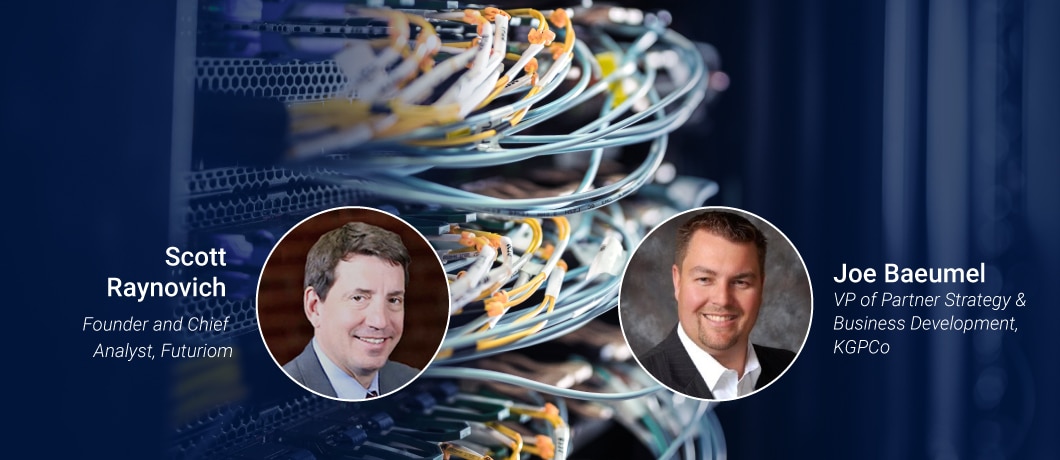Software-based Solutions Running on White Boxes
KGPCo sees a strong move in the industry toward software-based virtualized solutions that can run on standardized hardware, or white boxes — a trend known as disaggregation, and are a leading white box integrator to network operators. Baeumel says this is a lasting force in the industry because it gives network operators the opportunity to speed up innovation while lowering the cost of service delivery.
“There are many operational advantages of white boxes and the cloud,” says Baeumel. “You have to deliver something that is easily consumed by the end customer.”
Building Telco Networks
At KGPCo, Joe and the team are focused on the cloud and virtualization market and partner ecosystem. Baeumel started as an RF Engineer in the 1990s and worked at a series of consultancies deploying fixed wireless and wireless technologies. One of these consultancies was acquired by former equipment giant Marconi, which was acquired by Ericsson in 2005, which led him to years of building networks in the telecommunications industry.
KGPCo offers everything from testing, strategic consultancy and integration to outside plant construction and advanced logistic services – providing Customers the KGPCo OneTouch solution. Baeumel and the team are helping their telecommunications customers transition to the cloud and virtualized environment by using technologies such as NFV/SDN, Cloud, IOT, and 5G. He also works on developing more partner solutions.
Bringing DriveNets Network Cloud into Tier 1 Networks
KGPCo’s disaggregation solution partner is DriveNets. They started working together in 2015, helping deploy the software-based routing technology into operators worldwide, including a Tier-1 operator in North America.
KGPCo is involved with technology partners at the highest level, developing a deep model of integration that extends from testing and installation to support. This way, says Baeumel, the companies work together at every level to help their mutual customers. KGPCo deploys its 2200 employees to build integrated solutions at customer sites and supports them.
“We blend compute and network from a variety of vendors, storage solutions, including everything from minor materials to software. We build that and hand it over to our Inside Plant team to install with a particular customer. It’s a nice bundle, called KGPCo OneTouch solution. We couple that with advanced supply chain solutions and also provide maintenance and technical support.”
Incumbent Vendors Under Pressure
As somebody who worked at large incumbent telecom equipment suppliers, which Baeumel calls “house brands,” he says the tension is apparent in the industry. The incumbents have a large installed base that they can’t afford to cannibalize. At the same time, the leading operators are moving toward virtualization as fast as possible to improve operations as well as their cost structure.
“As far as the operators are concerned, there are leaders and there are followers,” says Baeumel. “There are operators in the telco and the MSO multiple systems operator space that have embraced the white box and are looking at a disaggregated solution. This increasing demand helps make disaggregated solutions more mature. We have been working on these business models to understand how to consume it. It’s a different architecture. Splitting it into its component parts. The KGPCo OneTouch addresses operators’ questions on how to install and manage it.”
One of the key areas for supporting innovation is providing a good support model for next-generation technologies – one of KGPCo’s strengths. The major incumbents like to paint next-generation solutions as risky for customers on the testing and support front. Baeumel sees it as incorrect.
“Traditional router vendors say the support model is more complicated. That is a bit of a myth. It can be the same. If you talk to the folks inside the lab, it’s all the same thing. There are ports on a box and software, and it all has to be evaluated.”
Joe Baeumel, VP of Partner Strategy and Business Development, KGPCo
Supporting the White Box Wave with DriveNets
KGPCo has built a substantial business, with 2,000 customers, by offering world-class integration and support, including innovation leaders in the startup space, such as DriveNets. KGPCo integrates DriveNets on top of the white box technologies, working with hardware vendors as well. Then its integration team builds the pods and clusters in the field. If something breaks, they manage the support ticket along with DriveNets.
“From a troubleshooting standpoint, it’s about giving them one hand to shake – we do that,” says Baeumel. The SLAs are in place to make sure the customer gets their resolution and time to recovery to make sure what they get is the same as traditional vendors.”
Baeumel believes that virtualization and white boxes are spreading in the network and will soon become a fact of life, dragging incumbents “kicking and screaming” to virtualized solutions.
“It started with SD-WAN and PE [provider edge] routers, but it’s going deeper and deeper. We are seeing it at the core, we are seeing it at CRAN [Cloud Radio Access Network] aggregation points if I’m a wireless operator, we are seeing it at cell sites, as we look at things like ORAN [Open Radio Access Network]. All those types of areas are targets for disaggregation.”
Integrating Virtualized Software Startups
Baeumel thinks virtualized software startups and ODMs have another advantage — they are hungrier and more likely to integrate.
“A lot of the operators have discovered if you move away from the house brands to the young companies like DriveNets, they tend to be more agile. You are going to find that certified features are developed much faster. This includes hardware features from Broadcom or Intel that become available much faster than from the incumbent vendors.”
Taking the word from this telecom expert, the virtualization wave is impossible to stop and will likely disrupt the single-supplier model in the future.
“We’re coming to a new, independent era of disaggregated technology,” he says.
Download White Paper
Introducing DriveNets Network Cloud




